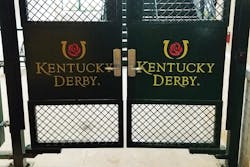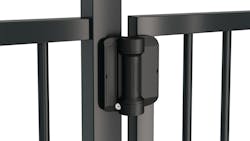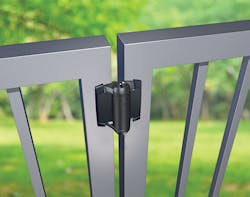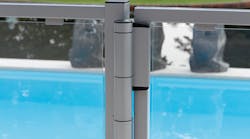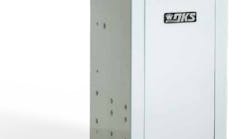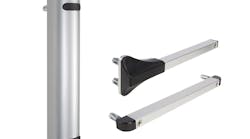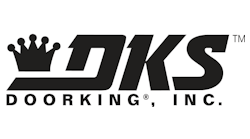Most people think of access to swimming pools when they think of gates, but gates also are used for pedestrians, vehicles and equipment, indoors and outdoors. Sometimes gates use electronics and electrical power. Gate types include swinging, sliding and barrier.
The ability to strategically deploy a gate system is a benefit to security management, but sometimes it can be difficult with regard to available power and security communications. Security communications might include an intercom, remote surveillance and remote control. Solar-powered and wireless options can help to solve such issues.
Regardless of the particulars of a gate deployment, the four top concerns are safety first and second, then security third and fourth. By this I mean that although we might use gates and fences to protect an area and whoever and whatever is within the protected perimeter, our mission isn’t achieved if we also create hazardous conditions for trapped occupants or impede emergency services.
Most security pros are familiar with the codes and regulations for doors but might not be as familiar with the rules that apply to gates. They should be, particularly if they believe that they’ll use padlocks on a gate. Means of egress and safe dispersal areas should be primary concerns.
Smooth Operators
Because gate systems can involve mechanical as well as electric or electronic aspects — and frequently site work — you might deal with outside contractors, electricians and safety agencies (authorities having jurisdiction, or AHJs) during the course of your gate work. In my vernacular, “site work” includes activities such as pouring concrete slabs, trenching cable and using carbide cutting wheels to imbed safety loops, all outside in challenging weather conditions.
You also should familiarize yourself with gate operators, which open and close a gate. Here are some places where gate operators are used:
Residential areas: This is a somewhat-relaxed environment, because you deal with a limited number of users and a limited number of openings, such as driveways or front yards in cities.
Gated communities: Hundreds of individuals and their vehicles might want to transgress the main gate as well as amenities, such as a pool or tennis courts.
Maximum security: Gates, mantraps and sally ports in courthouses, prisons and police stations are just a few examples of the heavy-duty hardware and systems you might design, install and maintain.
Traffic control: Parking lots and garages for commercial, government and educational campuses have real issues and concerns about safety and security, which means your systems must meet the demand and operate reliably.
Self-storage facilities: Controlling access and maintaining security for tenants and all their stuff is an important market segment.
Tool cribs: Within manufacturing facilities, products, machinery and raw materials are kept under “lock and key” as well as surveillance, because these items are vital assets of a company and must be protected.
Server facilities: I’ve done several of these, and gates and fencing go well with providing durable physical security while also allowing for the mandatory climate controls and visibility within these high-stake targets for cyberattack.
Retention ponds: These sound rather unglamorous and insignificant, but every year, kids drown in these and drivers make unscheduled dives into unprotected bodies of water.
Code Compliance
The standard to which vehicular-gate operators are designed, manufactured and tested is UL 325 – Standard for Safety: Door, Drapery, Gate, Louver, and Window Operators and Systems. In addition to the 325 standard, vehicular-gate operators also must also be tested to UL 991.
The UL 325 standard has undergone significant revisions over the past several years intended to create entrapment-protection criteria for vehicular-gate operators and systems and to increase overall product safety. The standard also lists specific construction specifications for the vehicular gate itself (see ASTM F2200). This category covers electrical and pneumatic door and gate systems, and door, drapery, gate, louver, window and turnstile operators, along with the controls and accessories. UL Listed gate systems are marked to specify all intended-use classes, along with their maximum rated closing force.
For decades the entrapment issue was a familiar concern to locksmiths involved with door operators. Full-energy swinging-door operators caused many injuries, particularly of children and elderly people who would get caught between a moving door and a hard place. Safety railings and external safety sensors are important accessories for use on any automated swinging-door system.
With respect to gates, entrapment protection for gates isn’t required for barrier-arm operators that aren’t intended to move closer than 2 feet from a rigid object, provided they don’t have pinch points between moving parts.
Gate Classifications
UL 325 includes specific requirements for vehicular-gate operators based on their intended use, as defined by one of the following four classifications:
• CLASS I – Those intended for use in a home of one to four single-family dwellings or a garage or an associated parking area.
• CLASS II – Those intended for use in a commercial location or building, such as a multifamily housing unit (five or more single-family units), hotel, garage, retail store or other building that services the general public.
• CLASS III – Those intended for use in an industrial location or building, such as a factory or loading dock area or other locations not intended to service the general public.
• CLASS IV – Those intended for use in a guarded industrial location or building, such as an airport security area or other restricted-access location not servicing the general public, in which unauthorized access is prevented via supervision by security personnel.
The types of required primary and secondary entrapment protection vary, depending on the gate classification and its intended movement. This protection can include the following methods, among other protection criteria:
•An inherent entrapment protection system that stops and reverses the gate within 2 seconds.
• A noncontact photoelectric sensor or the equivalent that stops or reverses the gate within 2 seconds.
• A contact sensor (edge device or the equivalent) that stops and reverses the gate within 2 seconds.
• An inherent adjustable clutch or pressure-relief device that, upon sensing an obstruction in any direction, will stop the gate and not result in a closing force of more than 10 percent more than the initial setting that’s required to stop the gate, which can’t exceed 40 pounds of force.
• An actuating device that requires continuous pressure to maintain the opening or closing motion of the gate. Upon removal of the pressure, movement of the gate must cease.
• An audio alarm.
In the Field
Of course, the ultimate safety of any gate system depends upon the proper installation. Particular attention must be given to the following:
1. That code authorities are consulted prior to installation.
2. Verification that the gate operator class is appropriate for the intended installation.
3. That installation is performed by a qualified installer who uses the manufacturer’s instructions.
4. That recommended safety devices, such as photoelectric sensors or reversing-edge switches, are installed properly.
The American Fence Association has resources and a training-certification program for automated gate operator system designers and installers. Visit www.americanfenceassociation.com for more information.
Another resourse is Door & Access Systems Manufacturers Association International (DASMA), a standards development organization accredited by the American National Standards Institute (ANSI). DASMA standards are available for download in PDF format at www.dasma.com.
Following are some products for your gate project. (Note that locks are a separate category and not included in this article.)
DoorKing 6006 Swing Gate Actuator
DoorKing provides a variety of gate access and security solutions that are aimed at the professional installation market. This means it has a wide range of products, a large distribution network for sales and parts and, probably most important, tech support. This is particularly appreciated when you want it. (DoorKing has removed the thorn from my paw on more than one occasion.)
The DKS 6006 Swing Gate Actuator provides convenience and reliability in a compact, aesthetic design. This actuator mounts directly to the gate and pilaster, which simplifies installation and doesn’t require concrete mounting pads. The screw-driven action is powered by a 24-volt DC motor, which eliminates the worry over hydraulic leaks, check valves or pumps. Built-in no-contact magnetic limit switches precisely control the start and stop speed of the actuator.
More info: www.doorking.com
Locinox Serval 180° Spring Hinge
The Serval is a compact spring hinge that has force adjustability. The fiberglass-reinforced polyamide housing protects the high-tech internal components, which allows for functionality in all weather conditions. Its 20mm vertical and horizontal adjustability ensures an easy and flexible installation.
The Serval is suitable for installation on square and round frames, and it uses self-drilling screws, so no welding is required.
The Serval is available in pairs or as a part of the FortiMa-Serval Pool and Park Set, which comes with the FortiMa gate latch. The set is aimed at pools and parks. The Serval is for gates up to 125 pounds.
More info: www.locinoxusa.com
D&D Technologies SureClose ConcealFit
The ConcealFit Door Closer & Hinge Set is part of D&D Technologies’ SureClose line of self-closing gate hinges. Although most models are flush- or center-mounted, the ConcealFit is mortised into the gate and frame.
The ConcealFit hydraulic door closer and hinge set is an all-in-one combination that’s aimed at use with bullet-resistant doors and safe-room doors, and at high-end hotels, offices and luxury homes. It’s adjustable and suitable for use aimed at Americans with Disabilities Act compliance.
D&D Technologies TruClose Hinges
D&D Technologies TruClose hinges for fences and gates are adjustable and self-closing and come in a variety of colors to match the materials of an existing backyard fence. A quick and easy tension adjustment can adjust the hinges to the applicable gate weight and desired closing speed. You simply use a large screwdriver at either end of the hinge barrel to make the adjustments.
TruClose hinges can be used indoors at childcare facilities or outdoors surrounding personal and public pools or pools. TruClose hinges are made from a UV-stabilized industrial-strength polymer and stainless steel components for long-lasting performance.
D&D Technologies Shut It Hinge-Closer Set
D&D Technologies Shut It BadAss Hinge-Closer Set is an easy-to-install self-closing hinge set for gates of up to 300 pounds. It has five tension-adjustment settings and allows for a gate swing of up to 110 degrees. It is aimed a range of gate applications, including driveways and commercial gates.
More info: https://us.ddtech.com
LockeyUSA Gate Closers
Whether it’s for residential or commercial use, LockeyUSA offers gate closers for lightweight and heavy-duty high-use gates.
LockeyUSA hydraulic gate closers are easy to install on a variety of gate materials, including ornamental, vinyl, wood and chain link. For chain-link gates, LockeyUSA LINX kits make for an easy installation of the gate closer (TBLINX, TB950LINX).
LockeyUSA has two lines of gate closers:
SUMO SafeClose hinges, in regular and heavy-duty models , are adjustable-tension gate hinges for pool and safety gates of up to 99 pounds or 187 pounds, depending on the model. The EZ click tension adjustment will control how fast the gate closes. The hinges are rust-free and bind-free and resistant to extreme weather.
The TB line has a range of models up to the TB950 Magnum. The range of products deliver a quiet, hydraulic action for the reliable closing of pedestrian gates 30–72 inches wide and 50–250 pounds for use at hotel pools, parking lot or beach access, office complexes, resort gates and barrier gates.
The TB950 Magnum is a concealed heavy-duty hydraulic closing system designed to act as a closer and hinge. The TB950 has been million-cycle tested and operates in temperatures that range from minus-40 degrees Fahrenheit to 122 degrees F. It’s aimed at use in man-gates and other heavy systems. The TB950 also can be installed on chain link.
More info: www.lockeyusa.com
Tim O’Leary is an experienced security consultant and a regular contributor to Locksmith Ledger.
